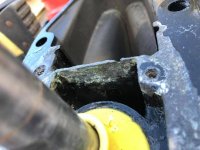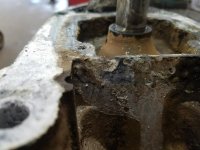HI all:
I'm convinced I have broken off flapper valves stuck in the transom assembly on my engine and am looking for suggestions on how to determine if this is true.
twin 2001 5.7 2bbl with Alpha 1 Gen2.
the starboard engine overheated july 2017. not too bad though... I was doing a WOT test and was on the pins for about 4 min and the temp reached 200 and triggered the alarm so I shut it down.
to remedy the overheat condition I changed out the manifolds, risers, all hoses, water pump and flapper valves. overheat condition is gone and engine has run another 170 hours with no overheat condition.
when doing the manifold job I found that both petals of the starboard flapper was gone and one petal of the port flapper was gone. I reached down into the y but never found anything and nothing was in the outdrive either. Also there was blistering on the large rubber joints between the risers and the Y pipe indicating the high temp.
ever since that day the engine has started rougher and smoked black smoke on start up and refuses to run to WOT either under weigh or at idle. the risers on the starboard motor are also noticeably hotter than the port engine. too hot to keep your hand on. The port motor never gets too hot to hold your hand on.
Once warmed up however and when run at normal cruising speeds the starboard engine never misses a beat and performs flawlessly
I just pulled the boat for the winter and ran it on muffs to flush it. there was a lot of black smoke till it warmed up and it took forever for water to come out of the two exists on the transom assembly and when it did come out it was only a trickle. the port engine on the other hand pumped lots of water out all opening within a few seconds of starting.
at this point I believe that my missing flapper valves are restricting exhaust somewhere in the transom assembly.
I have the outdrives removed now and still can't see antthing. I can reach my hand down the Y pipe till it bends aft. there's only about 12" of the transom assembly that I can't feel or see and I believe my 3 missing petals are in there.
Love to hear your recommendations on how to dermine if this is true and if so how to remove (is this an engine out situation?)
thanks
John
I'm convinced I have broken off flapper valves stuck in the transom assembly on my engine and am looking for suggestions on how to determine if this is true.
twin 2001 5.7 2bbl with Alpha 1 Gen2.
the starboard engine overheated july 2017. not too bad though... I was doing a WOT test and was on the pins for about 4 min and the temp reached 200 and triggered the alarm so I shut it down.
to remedy the overheat condition I changed out the manifolds, risers, all hoses, water pump and flapper valves. overheat condition is gone and engine has run another 170 hours with no overheat condition.
when doing the manifold job I found that both petals of the starboard flapper was gone and one petal of the port flapper was gone. I reached down into the y but never found anything and nothing was in the outdrive either. Also there was blistering on the large rubber joints between the risers and the Y pipe indicating the high temp.
ever since that day the engine has started rougher and smoked black smoke on start up and refuses to run to WOT either under weigh or at idle. the risers on the starboard motor are also noticeably hotter than the port engine. too hot to keep your hand on. The port motor never gets too hot to hold your hand on.
Once warmed up however and when run at normal cruising speeds the starboard engine never misses a beat and performs flawlessly
I just pulled the boat for the winter and ran it on muffs to flush it. there was a lot of black smoke till it warmed up and it took forever for water to come out of the two exists on the transom assembly and when it did come out it was only a trickle. the port engine on the other hand pumped lots of water out all opening within a few seconds of starting.
at this point I believe that my missing flapper valves are restricting exhaust somewhere in the transom assembly.
I have the outdrives removed now and still can't see antthing. I can reach my hand down the Y pipe till it bends aft. there's only about 12" of the transom assembly that I can't feel or see and I believe my 3 missing petals are in there.
Love to hear your recommendations on how to dermine if this is true and if so how to remove (is this an engine out situation?)
thanks
John



